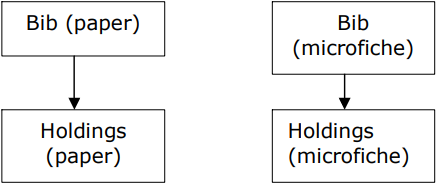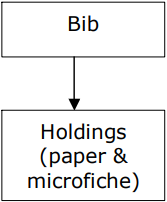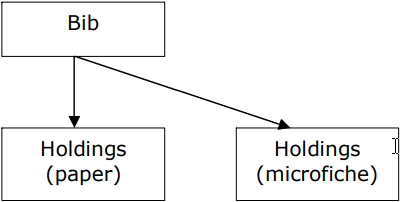Z39.71
The ANSI/NISO Z39.71 holdings display standard is a combination of two things: the conceptual holdings elements (officially called Data Areas), and nine principles for recording the holdings elements (officially called the Principles).
Data areas & data elements
There are six Data Areas, or fields. A Data Area can sometimes be further subdivided into multiple subfields. These are officially referred to as Data Elements. The order of the Data Areas is not specified by the standard. However, within each Data Area, the order of the Data Elements is prescribed. The six Data Areas are:
- Item Identification Area. This is the link from the holdings record to the bibliographic record; it identifies the bibliographic record the holdings record should be attached to. The actual link (technically referred to as the identifier) can vary: ISSN, ISBN, OCLC record number, etc. It can even be a partial bibliographic description.
- Location Data Area. Identifies the exact location of the item. It can be in free text, although some systems mandate specific formats. It has four Data Elements: the library code, the branch or sublocation, copy number, and call number.
- Date of Report Area. The date the holdings record was created or updated. It is recorded in YYYYMMDD format. An unknown date is recorded as 00000000.
- General Holdings Area. Contains general holdings information, such as whether an item is a book or a DVD. This is subdivided into five Data Elements, and each element has a series of coded values. Systems typically convert the coded values into full-text for OPAC displays:
- Type of Unit: Is it a volume, a supplement, or an index?
- Physical Form Designator: Is it a hardback, a paperback, or an ebook?
- Completeness Designator: If it's a serial, how much of the serial do you hold?
- Acquisition Status Designator: Is it on order, currently acquired, or ceased publication?
- Retention Designator: The library's retention policy. Is the item retained until replaced by microfilm? Or permanently kept?
- Extent of Holdings Area. For serial publications, this field contains specific holdings information about the range of volumes held by the library. It consists of five Data Elements:
- Name of Unit: Is it a volume, an issue, a bund, or a tome?
- Extent of Unit: How many parts does the item have?
- Enumeration: The actual number of the volume.
- Chronology: The date on the volume.
- Specific Extent Note: Information clarifying the contents of any of the other Data Elements (e.g., bound, unbound).
- Holdings Note Area. Free-text note field relating to the holdings (not the bibliographic record). Examples of notes include whether or not the item circulates, or its physical condition.
Exercise 1: Identify Z39.71 data elements
For each piece of information given below, identify the Z39.71 data area and, where applicable, the data element. The first one has been completed for you as an example. The answers can be found in the Exercise answer key.
| Information | Data area | Data element |
|---|---|---|
| Holdings 60% complete | General Holdings Area | Completeness Designator |
| Library has more than one copy | ||
| Subscription is no longer active | ||
| Library retains last 5 years | ||
| Library owns volumes 1 to 10 | ||
| Library owns 1990-1999 |
Nine principles
Z39.71 lays out nine principles, or major concepts, that holding records need to adhere to.
- Levels of Specificity. There are four levels of specificity, ranging from a simple statement that the library holds the item on up to a complex, detailed statement of exactly what parts of the item are held. ANSI/NISO is discussing adding a fifth level that would include a barcode. See Table 1: Levels of Specificity for examples.
- Identification of Data Elements. Data Elements are identified, or set off from each other, by punctuation. Punctuation is prescribed within two Data Areas (the General Holdings Area, and the Extent of Holdings Area), but does not need to be consistent from Data Area to Data Area. See Table 2: Punctuation for punctuation definitions.
- Optional Data Area or Element. The standard designates each Data Area, and each Data Element, as being mandatory, not used, or optional in a holdings record. This may vary with the Level of Specificity of the holdings record, in that a Data Area may be optional for one level but required for another level.
- Pieces Held. For Level 1 - 3 holdings statements, the standard focuses on the parts of the item that are held, rather than those parts that are not held. Gaps can optionally be recorded in the Holdings Note Area.
- Number of Locations and Copies. If a library holds multiple copies in multiple locations, it has two options:
- Create multiple holdings records, one for each copy or location.
- Create one holding record (a "composite" record) reflecting the multiple copies or locations.
- Form. Holdings my be recorded in either compressed or itemized form. Additionally, the same holdings record could have both compressed and itemized holdings information.
- Cataloging System. The holdings standard is independent of a cataloging system or code. When Z39.71 conflicts with AACR2, use Z39.71. Put another way, AACR2 is for bibliographic records, and Z39.71 is for holdings records.
- Relationship of Holdings Statement to Bibliographic Item. The holdings record will link to only one bibliographic record. However, the bibliographic record itself may reflect multiple items (e.g., a series, supplements).
- Formats. If a library holds multiple versions of the same item (e.g., it holds both the paper and microfiche for Time magazine), it has a few options for how many holdings records to create, and which bibliographic record or records to link to.
Option A: Multiple bibliographic & holdings records. Create separate bibliographic records, one for each format. Then, create separate holdings records.

Option B: Create a single, bibliographic record. It may represent all formats, or it may represent just the paper. Then, create a single, composite holdings record.

Option C: Create a single, bibliographic record. It may represent all formats, or it may represent just the paper. Then, create multiple holdings records.

Table 1: Levels of specificity
Table 2: Punctuation
Exercise 2: Interpret Z39.71 holdings records
Look at the following holdings records. Then, identify the data areas/data elements and answer the questions. For this set of exercises, the library code is W7L. The answers can be found in the Exercise answer key.
- The item is a multi-volume monographic set, and the ISBN is 0-252-18123-1. The subscription is complete (i.e., has come to an end).
0252181231 W7L 19890524 (a,ta,4,2,8) v.1-v.20- How is the library linking to the bibliographic record in the Item Identification Area?
- What level is this holdings statement?
- When was this holdings record last modified?
- Which data element(s) are reported in the Location Data Area?
- The item is a printed text. The library also subscribes to the microform version. The ISBN is 0-904351-114, and the Call Number started with PZ.
0904351114 W7L C2 PZ7.D684 A1 1997 19970303 (a,ta,0,0,8)- What data elements has the library reported in the Location Data Area?
- Based on the previous answer, what copy does this holdings record represent, and what call number is it shelved in?
- The item is a multi-part videocassette. In the library's OPAC, the bibliographic record the item links to is 0054378.
0054378 W7L HN535.2M2J68 19940525 (a,vf,2,0,8) No.1-No.14 VHS. Does not circulate- How is the library linking to the bibliographic record in the Item Identification Area?
- Is this library classifying its videocassettes?
- What is the last Date Area listed? And what does it indicate?
Extra challenge: In what Data Element is the code for the item's physical form, and can you guess the code for a videocassette?
Two descriptive dimensions for holdings
Principles one (Level) and six (Form) are frequently confused with each other. More specifically, the terms "summary vs. detailed" (i.e., levels 3 and 4) and "compressed vs. itemized" are often expressed as something like "summary vs. itemized" or "compressed vs. detailed". In fact these principles, and their respective terms, define two different dimensions for describing a holdings statement:
| Summary Level "Highest Level" | Detailed Level "All Levels" | |
| Compressed Form "First, Last" | v.1-v.4 | v.1:no.1-v.4:no.12 |
| Itemized Form "All Items" | v.1 v.2 v.3 v.4 | v.1:no.1 v.1:no.2 v.1:no.3 v.1:no.4 |
Thus, the holdings statement v.1-v.4 is both summary and compressed, and the holdings statement v.1:no.1 v.1:no.2 v.1:no.3 v.1:no.4 is both detailed and itemized.
Exercise 3: Form and level of holdings
For the following holdings records (in the Extent of Holdings Data Area), determine both the form and the level of holdings. The first one has been completed for you as an example.
| Holdings record | Nivel | Form |
|---|---|---|
| v.1-8(1993-1996) | Summary | Compressed |
| v.108:no.1-v.108:no.18 | ||
| 1990,1995,1996,1997 | ||
| 1908:Jan. 1908:Feb. 1908:March | ||
| v.78(1983)- | ||
|
Extra challenge: v.22:no.1-v.22:no.6,v.23:no.1, v.23:no.2, v.23:no.3 |
Other items of note
Z39.71 adopts many of the practices of its preceding standards (Z39.42, Z39.44, and Z39.57), and also attempts to adhere to the international standard (ISO 10324). As a result, past practices that were prescribed may be optional in the current standard. This section outlines some of these new options.
Itemized vs. compressed holdings
An itemized holdings statement lists each part of the unit held. By contrast, a compressed holdings statement lists only the first and the last part in the range of units held. A holdings statement may be itemized, compressed, or a combination of the two.
Ordering of enumeration and chronology
Enumeration and chronology data may be recorded separately, and with or without parentheses. Or, they may be recorded adjacent to each other. In this case, parentheses must surround the chronology.
Separate: v.1-v.5(1923-1928) or v.1-v.5 1923-1928
Adjacent: v.1(1923)-v.5(1928)
Numbered and unnumbered series are the exception. The series designator and the second-level enumeration are always recorded together. For example, series one volume one to series three volume two would be recorded as: Ser.1:v.1-Ser.3:v.2.
Captions
Under the current standard, recording the caption with the enumeration is optional but highly recommended. Thus, volume 1 can be recorded as both v.1 or 1.
When recording a range of holdings, captions can be recorded either at the beginning of the range or repeated throughout the range. Thus volumes 1 through 23 can be recorded as both v.1-23 or v.1-v.23. Captions should always be repeated when needed for clarity.
All caption abbreviations should be done according to AACR2 B, "Abbreviations". If the caption is not listed in Appendix B, then spell it out in full. Thus, supplement is recorded as suppl. but supplemento is recorded as supplemento.
Similarly, if the number has no caption, do not supply it; record only the number.
Ordinal numbers
Ordinal numbers (1st, 2nd, etc.) may be recorded as either ordinal or cardinal numbers (1, 2, etc.). If ordinal numbers are recorded, the number should be abbreviated according to AACR2 Appendix C, "Numerals".
Exercise 4: Code Z39.71 holdings records
Library W7L owns one copy of the serial Discover. The ISSN is 0344-8577. The subscription is current, and it began in 1990 with volume 26. The library links its serial holdings to the bibliographic record with the ISSN. Based on this information, code a basic holdings records with the date Jan. 1, 2008:
Library W7L owns two copies of Time magazine. The ISSN is 0444-8731. The paper subscription is held for the current 3 years. The microform subscription began in 1971 and is current. The library links is serial holdings to the bibliographic record with the ISSN. Based on this information, code a basic holdings record for the microform with the date Jan. 1, 2008. The physical form Designator code for microform is hu:
